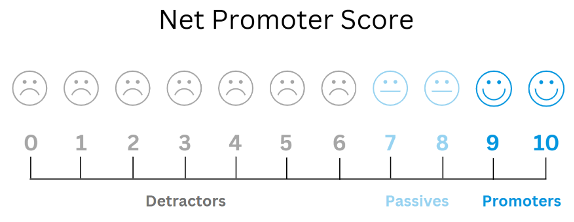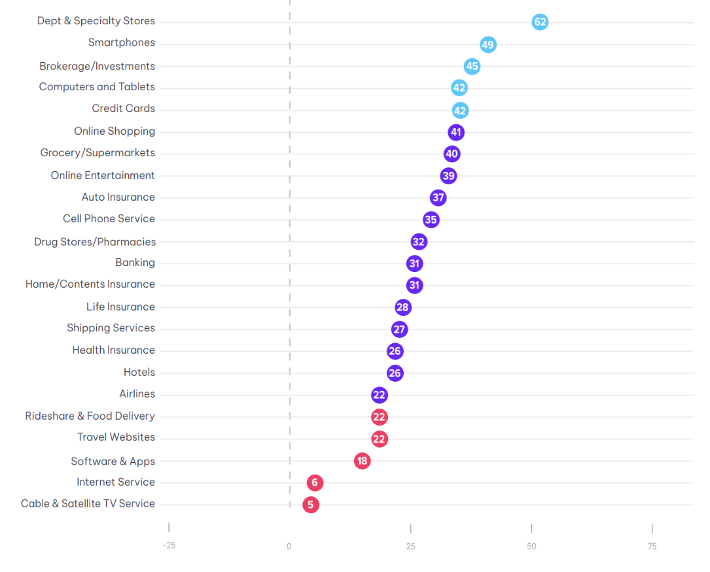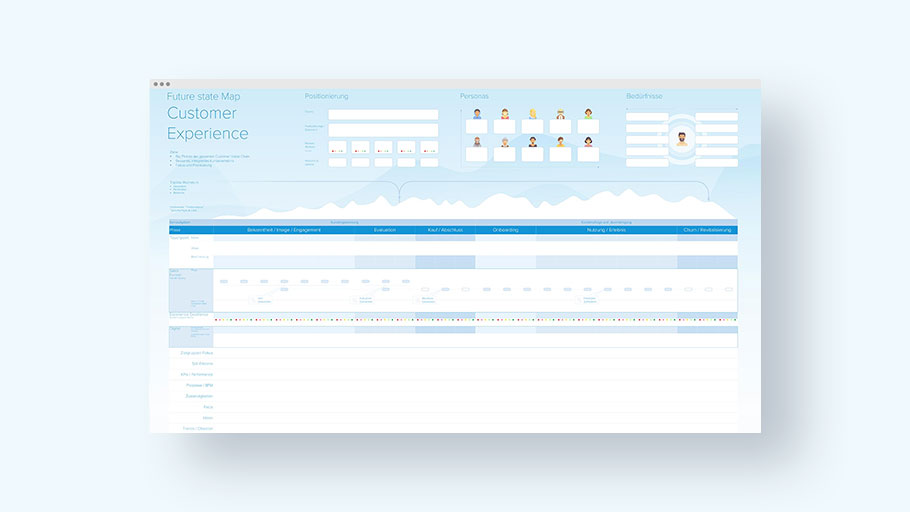How is the NPS measured?
“How likely are you to recommend our company to others?”
The aim of this question is to find out how willing customers are to recommend the company to others. The answers are given on a scale from 0 to 10 (very unlikely to very likely).
The answers can be divided into three categories:
- Promoters (very likely)
- Passives (rather unlikely)
- Detractors (very unlikely)

Example: 25% of respondents give a value between 0 and 6 and 40% either 9 or 10. This therefore means a Net Promoter Score value of 15 (40 % – 25 %).
Possibilities for surveying the NPS
There are two common methods for collecting the Net Promoter Score: the absolute method and the relative method.
Absolute method
The absolute method refers to the assessment of the NPS against a defined threshold. Thus, on a scale of -100 to 100, any value greater than 0 is considered “good”. This in fact means that the promoters outweigh the critics. But since an NPS value of 0 means doing only the minimum, in most cases it should be quite a bit higher. As a rule, this must be above 50 to be considered above average, in an absolute sense.
The threshold value can be set individually and depends on the goals as well as the use of the NPS at the company.
Relative method
The relative method of surveying the NPS, on the other hand, refers to measuring the NPS in comparison with other companies in the same industry. In other words, the results are compared to the industry average. This can help you show where you stand in the market. However, the comparison with others should be taken with a grain of salt, but more about that later…
Where is the NPS surveyed?
Customer satisfaction can be measured at various touchpoints. In addition to the classic purchase of a product, there are a variety of other possibilities. Here are a few examples:
- Customer service: Customer service is an important point of contact for customers and is therefore particularly suitable for checking the NPS.
- Online shopping: The user experience when shopping online can also be checked using the NPS.
- Use of services: The NPS can also be measured when using services, for example when visiting a gym or going to a restaurant.
- Use of software: The user experience when using software can also be checked using the NPS.
- Participation in events: The NPS can also be measured when participating in events, such as conferences or trade fairs.
We recommend that you start with your company’s most relevant touchpoints and query additional touchpoints over time. By prioritising your company’s most important touchpoints, you ensure the greatest possible leverage.
How often should the survey take place?
The frequency of the NPS measurement depends on the company’s goals and expectations. However, it is recommended to measure the NPS regularly in order to identify changes in customer satisfaction and to be able to react.
What is a good NPS score?
What a «good» NPS value is cannot be answered in a uniform way. A good NPS score depends on several factors and can vary from industry to industry. We recommend using a mix between empirical values and the industry in which you operate.
The industry values are approximate values that you can use as a guide. In different industries, different values can be considered good. Industries that have a more difficult standing with customers per se, such as airlines, usually also have a lower NPS value.


Free template for optimizing the customer experience
Looking for an easy-to-use template to help you visualize and optimize your company’s customer experience?
Our template offers you a simple way to display the steps and touchpoints of your customers at a glance and identify optimization potential.
The comparison with companies from the industry can be quite useful. However, you should always keep in mind that benchmarking using NPS can be difficult. This is because not all companies measure satisfaction in the same place and with the same customer group. For example, customers who have been with your company longer usually have a higher NPS than new customers.
In addition, by comparing within the industry, you also set an artificial limit.
What to do if the NPS score is poor?
But what now, if your NPS value is not satisfactory and you want to improve it? You can do this in the following ways:
- Add to the classic question – How likely are you to recommend our company to others? – further open questions to collect additional qualitative data.
- Focus on specific feedback from detractors to derive action items.
- Engage with Detractors to see what you can do as a company to improve.
- Do not focus too much on individual values, but observe the development of the NPS value over a longer period of time.
Advantages and disadvantages of the NSP
Alternative measurement of customer satisfaction
In addition to the NPS, there are the following alternatives for measuring customer satisfaction:
- Customer Satisfaction Score (CSAT): Customer satisfaction is indicated on a scale (1-3, 1-5 or 1-10). However, since the CSAT addresses a feeling (satisfaction), it is highly dependent on mood.
- Customer Effort Score (CES): Asks how much effort a customer had to put into solving a problem. Easy problem solving is associated with a good customer experience and higher satisfaction. Loyalty therefore increases as the effort required decreases.
- Things Gone Wrong (TGW): Measures the number of complaints per 100, 1,000 or 100,000 units sold.
Takeaways
The NPS measures customer satisfaction based on a single question. This was “How likely are you to recommend our company to others?” Measured on a scale of 0 to 10, the NPS can be surveyed in absolute or relative terms. In the absolute method, the assessment is based on a defined threshold value; in the relative method, the results are compared with the industry average.
NPS = Promoters (in %) – Detractors (in %)
where 0-6 = Detractors | 7 & 8 = Passives | 9 & 10 Promoters
The NPS can be measured at various touchpoints. In addition to the classic purchase of a product, for example, customer service, online shopping or the use of software. How often the survey should take place depends on the goals and expectations of your company.
A comparison with companies from the same industry can be quite useful. However, you should always keep in mind that satisfaction can be measured in different places or among different customer groups. Therefore, we recommend using a mix between experience scores and the industry in which you operate.
If the NPS value is not satisfactory, we recommend that you collect additional qualitative data so that you can understand the dissatisfaction and respond to it in a targeted manner.
Want to improve your NPS score? Contact us today to discuss your strategy.
You might also be interested in
Customer Journey: The 6 Phases
Customer Experience (CX): Definition, strategies and examples
